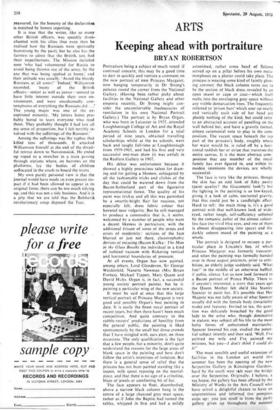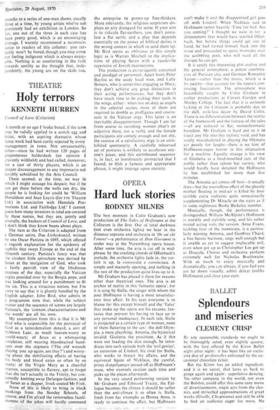ARTS
Keeping ahead with portraiture
BRYAN ROBERTSON
Portraiture being a subject of much vexed if continual concern, this may be a good time to dart in quickly and venture a comment on the new portrait of HRH Princess Margaret, now hanging temporarily in Dr Strong's palazzo round the corner from the National Gallery. (Having been rather picky about facilities in the National Gallery and other emporia recently, Dr Strong might con- sider the uncomfortable inadequacies of ventilation in his own National Portrait Gallery.) The portrait is by Bryan Organ, who was born in Leicester in 1935, attended Loughborough College of Art and the Royal Academy Schools in London for a total period of nine years, obtained travelling scholarships whilst at the RA schools, went back and taught full-time at Loughborough from 1959-1965, and had his first and very successful one-man show (it was awful) in the Redfern Gallery in 1967.
His debut was unfortunate because it showed a highly precocious talent for draw- ing and for getting a likeness, subjugated by all the fashionable tricks and clichés of the day that could be watered down from the Bacon-Sutherland part of the figurative representational forest. The quality of his paint was tricksy and all this was garnished by a smartly-bright flair for raucous, not especially felt, dress fabric colour that hovered near vulgarity. But he still managed to produce a commodity that is, it seems, welcomed by a number of people who want a decent likeness in portraiture, with the additional frisson of some of the props and struts of modernity: sections of the face blurred or just not there, claustrophobic devices of encasing (Bacon-KafIca: The Man in the Glass Booth) the individual in a kind of isolated vacuum with flickering vertical and horizontal boundaries of pressure.
At all events, Organ has now painted. among others, Lord Glendevon, Sir George Weidenfeld. Nanette Newman (Mrs Bryan Forbes), Michael Tippett, Mary Quant and David Hicks. Organ is, in fact, a successful young society portrait painter, but he is painting a particular wing of the new society.
It must be said at once that this large vertical portrait of Princess Margaret is very good and possibly Organ's best painting to date. It is easily the finest royal portrait of recent years, but then there hasn't been much competition. And quite contrary to the rabble-rousers' predictions of hostility from the general public, the painting is liked spontaneously by the small but dense crowds that I have mingled with, ears alert, on three occasions. The only qualification is the fact that a few people, but a minority, don't quite understand the reasons for the large areas of blank space in the painting and here don't follow the artist's intentions of isolation. But there is a general sense of relief that the princess has not bcen painted standing like a teapot, with spout reposing on the mantel- piece, and that there is no sign of a crinoline, blaze of jewels or comforting bit of fur.
The face appears to float, disembodied, above a narrow black column bang in the centre of a large charcoal grey matt space, rather as if John the Baptist had turned the tables, whipped in first and had a mildly
astonished, rather cross head of Salome served up on a pillar before his own meta- -morphosis on a platter could take place. The princess is wearing some kind of faintly glow- ing coronet; the black column turns out to be the section of black dress revealed by an open shawl or cape or coat—which itself melts into the enveloping grey space without any visible demarcation lines. The frequently referred to 'prison bars' which soar up neatly and vertically each side of her head are plainly nothing of the kind, but could refer to an abstracted account of panelling on the wall behind her, and have a gravely formal, almost ceremonial note to play in the com- position. The vacant space beneath the top part of the princess's body, roughly where her waist would be, is ruled off by a hori- zontal reddish bar or stripe that traverses the entire canvas. It is the most abstract com- position that any member of the royal family has ever figured in, and within its modest intentions the devices are wholly successful.
The face is very like the princess, though the skin has an odd look of flaky pastry (paint quality? the Giacometti look?) but the lighting in the painting is so low-keyed, giving it a look of calm, nocturnal gravity, that this could just be a candlelight effect. Hard to tell: the main thing is, it's a good portrait with that well-known look of wide- eyed, rather lough, self-sufficiency softened by the romantic pallor of the almost colour- less face (no vivid blue eyes, and one of them is almost disappearing into space) and the darkly solemn mood of the 'painting as a whole.
The portrait is designed to occupy a par- ticular place in Lincoln's Inn, of which Princess Margaret was formerly treasurer, and when the painting was formally handed over in those august precincts, prior to exhi- bition, an elderly judge suddenly said, 'What fun!' in the middle of an otherwise baffled, if polite, silence. Let us now look forward to a Bacon portrait of Prince Philip. There is, if anyone's interested, a story that years ago the Queen Mother felt she'd like Stanley Spencer to paint her. It's possible that Her Majesty was not fully aware of what Spencer usually did with the female body (invariably nude) and features. Invited to tea, the ques- tion was delicately broached by the good lady to the artist who, though diminutive in stature, was subject all his life to the most hefty forms of unbuttoned matriarchy. Spencer lowered his cup, studied the poten- tial subject intently and then said, 'Well, I've painted my wife and I've painted my mistress, but you—/ don't think I could do it.'
The most sensible and useful extension of facilities in the London art world this summer has been the opening of the new Serpentine Gallery in Kensington Gardens, hard by the south west side near the bridge over the Serpentine. Originally. I believe, a tea house, the gallery has been offered by the Ministry of Works to the Arts Council who have seized a delightful chance to have an unpretentious and informal (no pompous steps up: you just stroll in from the park) gallery given up throughout the summer
months to a series of one-man shows, usually three at a time, by young artists who've not previously had an exhibition in London. So far, one out of the three in each case has been pretty good, which is an encouraging average. I warmly recommend a reconnaiss sance to readers of this column: you cers tainly won't be bored, though you may come out feeling indignant which is always enjoy-, able. Nothing is so comforting in the rush towards senility as the thought that, inde4 pendently, the young are on the skids too,































 Previous page
Previous page